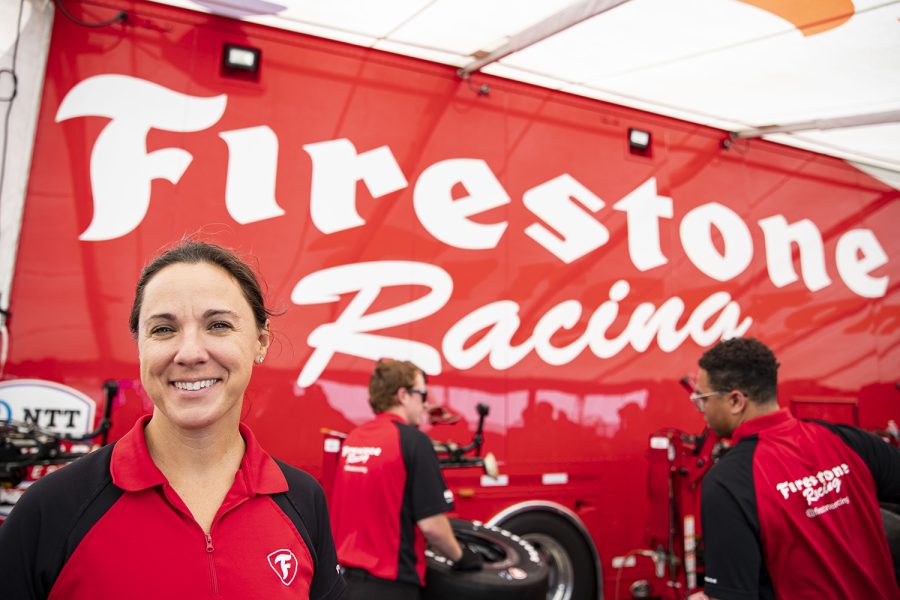Firestone’s chief race engineer discusses IndyCar tires and the Iowa Speedway
Cara Adams, the chief race tire engineer for Bridgestone and Firestone Racing, sits down with The Daily Iowan to discuss her career in racing and the intricacies of tire design for the race weekend at Iowa.
Chief Race Tire Engineer for Bridestone and Firestone Racing Cara Adams poses for a portrait before the Hy-Vee IndyCar Race Weekend Practice at Iowa Speedway in Newton, Iowa on Friday, July 22, 2022. (Ayrton Breckenridge/The Daily Iowan)
July 24, 2022
Inside the Firestone hauler at the Iowa Speedway sat Cara Adams, the chief race tire engineer for Bridgestone and Firestone Racing.
As the chief race tire engineer, it’s Adams’ job to design tires used in every IndyCar race weekend.
Adams said Iowa has a unique racing surface, providing challenges from an engineering standpoint.
“It’s very bumpy,” she said, “With those bumps come some really high impact and high loads to the tires.”
Iowa Speedway, on top of being filled with bumps, is also a short track. At only ⅞ of a mile, the car is spending a large percentage of the time turning, which puts a lot of heat into the tires. Because of this, Adams said, it’s important to design a tire that is able to handle bumps but is also durable enough to maintain long lateral loads and force.
Adams said they find out how to build the right tire with data analysis, testing, and computer modeling. From there, the engineering team is able to choose from a range of compounds or design a new compound if needed.
Because Iowa Speedway is an oval, meaning the cars only turn left, more weight and pressure is put on the right side tires. Consequently, Firestone’s tire sets for oval tracks are made up of two different compounds, one for the left side of the car, and one for the right side. The left side tires are soft, which provides more grip and makes the car easier to turn. The right side tires are harder, allowing them to handle the heavier loads they’re forced to deal with.
Firestone also uses stagger for the tires they use at ovals, Adams said.
“Stagger is the difference in diameter of the larger outside right rear tire to the smaller inside left rear tire,” Adams said.
She compared stagger to rolling a pint glass on its side.
“If you push a pint glass, of course it’s going to roll in the direction of the smaller side of the glass,” Adams said.
She said the same applies to race cars. The tires are designed so that even if the car were to be pushed straight forward, it would still veer left.
Adams first became interested in racing when she was studying mechanical engineering at the University of Akron.
“I knew nothing about racing, not much about cars at all, but I wandered down into the machine shop where they design and build the cars they use in Formula SAE [a collegiate racing design series],” Adams said.
From there, Adams joined the team and started working on the car. Later, she got the opportunity to drive the car. She said the experience made her decide she wanted a career in racing. That’s when she got a job at Firestone.
“I started on a group that was matching the right tire to the right vehicle. So if we were working on an Acura TL, for example, we would look and make sure the tire was tuned for that particular vehicle,” Adams said.
Adams said while she enjoyed that role at Firestone, she knew she wanted to work in racing.
“I found the manager at the time and I essentially pestered my way into the racing department,” Adams said. “I asked him what kind of skills or traits an ideal engineer would have and he came back and gave me a list of things. And I went out and I studied and I bought textbooks.”
Adams said in doing this, she basically had an answer key for what to do to work her way into the racing department. She got a job designing the tires for road and street courses in 2007 before taking over the engineering and production side of things, earning her current position of chief engineer for Bridgestone and Firestone Racing in 2017.
By the end of the weekend, each IndyCar team will have gone through up to 14 sets of Firestone tires before packing up and heading to Indianapolis next week.



